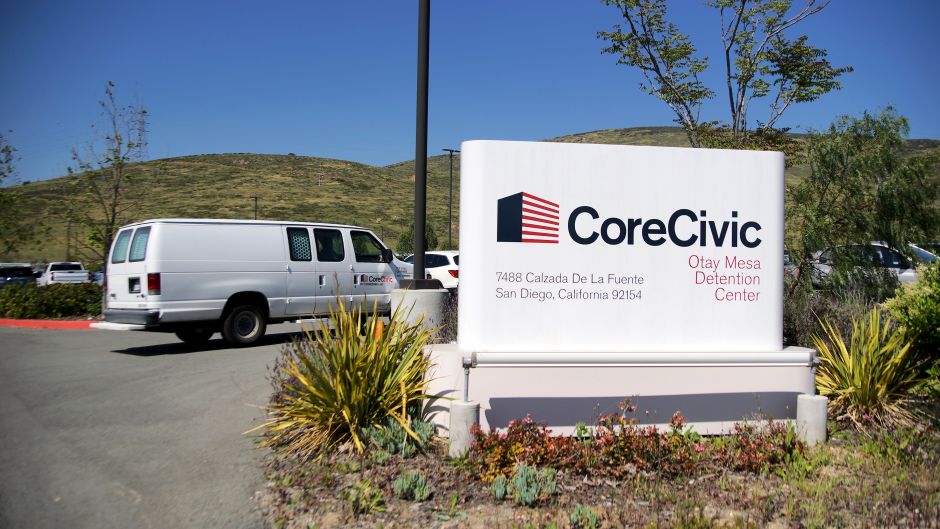ACLU Organization estimates that this total includes immigrants wanted by federal agents; as well as people seeking asylum and collateral arrests
Adrián and Yasmani, who preferred to use other names to protect their identity, say they are still unable to assimilate that at the Otay Mesa detention center – located in San Diego – a guard, who later learned that he had been infected with COVID-19, was He would remove the mask from his face to cough at the migrants.
Both Cubans, who form a gay couple, explained that “it was horrible to be there… [Que fue como estar] in like another world ”.
The pandemic was already registered outside the detention center but a short time later, a guard and a first migrant were infected.
“When the coronavirus started, we went on a hunger strike because they didn’t give us masks. [Los guardias] they started attacking us. They appeared dressed in black with tear gas guns and threatened us… They ordered us to return to the rooms, ”Adrián said.
Yasmani recalls that “they took about seven people from our section, because a guard had coronavirus.”
He adds that “[el celador] he took off his mask and was coughing. After he stopped coming to work for about two weeks, they quarantined our section. “
“Everyone realized that our section had COVID-19 and that’s when we started to worry the most. We were stuck there but they [los guardias] they didn’t take any action… They didn’t give us anything and we couldn’t keep any distance ”.
They explained that if someone from the section got sick, they would take that person out of the area for a week and after that they would bring the person back.
“As someone who is HIV positive, I was afraid that I would not survive if I got sick there,” Yasmani said.
As we left the detention center, near the San Diego border with Mexico, “we felt good to be able to breathe fresh air again,” he said.
Pandemic and arrests
This story is based on what the two Cuban migrants who traveled to Guyana, from there to Brazil, told the ACLU; and by land they managed to reach Tijuana, Mexico.
At this last stop, they had to wait months to get through in order to seek asylum, only to be sent to the border patrol “ice chest” and then to the Otay Mesa detention center.
They are just two of 525 migrants that the American Civil Liberties Union (ACLU) has managed to free from detention centers so far since the pandemic.
But the largest non-profit legal organization in the country estimates that so far in the health contingency, the Immigration and Customs Enforcement (ICE) office has detained 70,000 people nationwide.
The arrests range from people ICE are looking for to immigrants who are at the scene of the raid but end up caught – whom the agency calls “collateral” arrests. They even lock up those who, like Adrián and Yasmani, do everything in accordance with international law, the right of asylum and provide evidence.
Even now, Yasmani says he feels bad “because I have an electronic ankle monitor on and that makes you feel like you are still a prisoner.”
It indicates that ICE agents “call you at night, at all times and again at dawn. During the process, you cannot work. We don’t have a job… We are not independent ”.
However, both are happy to have come out of a confinement where COVID-19 threatened.

Contagions behind bars
According to ICE information provided to La Opinion this Monday, the agency recognizes that 45 of its agents in detention centers have been infected with COVID-19, in addition to 850 detained migrants.
ICE reports that, of that total, 167 migrants in Otay Mesa were infected with the coronavirus. But the official figure has only increased by one migrant in a couple of months.
In June, they said they had 166 infections.
Officially and according to ICE, only 5 migrants have lost their lives to COVID-19 in detention centers.
During the administration of President Donald Trump, ICE arrests, including those made by Customs and Border Protection (CBP) to those who cross the border to request asylum, have skyrocketed.
In the three and a half years of the Trump administration, 40 new detention centers have opened and now the global capacity of all centers is 80,000 detainees as a permanent number.
Some migrants are released on parole, others are deported, but the level of arrests continues.
The ACLU says that “the COVID-19 crisis once again exhibited the deep-seated negligence in these detention centers.”
He stated that while the country stayed in their homes, detained immigrants have been forced to cope with the pandemic in overcrowded conditions, without proper cleaning protocols or, in some cases, even basic sanitation supplies like having a soap.
Claim in California
However, Pedro Ríos, the border project director for the American Friends Service Committee, held Governor GavinNewsom responsible in part for the high number of ICE detainees during the pandemic.
“Since the pandemic reached California, we have asked the governor to order the handover of California state prisoners to ICE, some of whom have even served their sentence, and the governor has turned a deaf ear to the requests.”
Ríos said there is no exact number of people California has turned over to ICE in the last six months, “but it is a considerable number, surely higher than any other state.”
The activist confirmed that a coalition of organizations will continue to protest to demand that the governor “stop sending to detention centers” even people with a higher risk of infection. “







